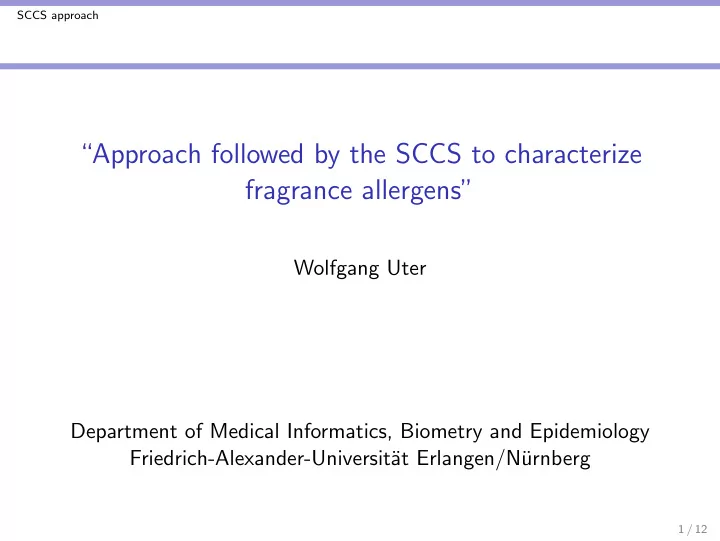

SCCS approach “Approach followed by the SCCS to characterize fragrance allergens” Wolfgang Uter Department of Medical Informatics, Biometry and Epidemiology Friedrich-Alexander-Universit¨ at Erlangen/N¨ urnberg 1 / 12
SCCS approach Contents Background: Definitions Retrieval, Grading and Aggregation of Evidence Discussion 2 / 12
SCCS approach Background: Definitions General definition of a contact allergen A substance which is capable of . . . ◮ inducing contact sensitisation in man after penetration and binding to epidermal proteins (“micro level”) ◮ eliciting allergic contact dermatitis after sufficient exposure, “sufficient” varying inter-individually (“clinical level”) 3 / 12
SCCS approach Background: Definitions Clinical definition of a contact allergen A substance, or a natural mixture of substances, ◮ to which the patient has (undoubtedly/probably/possibly) been exposed, areas of contact (perfectly/partly) corresponding to areas of dermatitis, with plausible time course, ◮ which elicited a (weak/strong/extreme) allergic patch test reaction to a (too low/adequate/too high) patch test concentration, in a (suboptimal/adequate) vehicle, ◮ the avoidance of which will ensure the patient is (mostly/perfectly) free of recurrences in the future 4 / 12
SCCS approach Background: Definitions Operational definition of a fragrance contact allergen in the SCCS opinion A fragrance substance, or a natural mixture of substances (extract), which (after bio − activation), ◮ based on several published reports of sufficient quality, has caused contact sensitisation in patients, or ◮ according to a historical human max. test / HRIPT is a sensitiser, or ◮ has been identified as contact allergen in guideline animal methods (effectively, only the LLNA), or ◮ can be categorised as likely allergen if limited human or experimental data is combined with structure activity considerations 5 / 12
SCCS approach Retrieval, Grading and Aggregation of Evidence Sources of Evidence ◮ Manual search of the journal “Contact Dermatitis” (Oct. 2010) ◮ Medline search of CAS numbers identified in reviews and clinical studies already retrieved ◮ Manual search of all RIFM reviews published in “Food Chem. Tox.” (last 20 years) ◮ “top 100” substances in terms of volume used (as supplied by IFRA) ◮ “top 101-200” substances if R43 ◮ Animal test data (GPMT, LLNA, Buehler test) requested from IFRA – eventually, LLNA protocol summaries regarding 59 fragrances were presented and considered along with two published reviews 6 / 12
SCCS approach Retrieval, Grading and Aggregation of Evidence Grading of Evidence Human data overrules other data ◮ HMT / HRIPT: predictive value positive: OK; . . . negative: doubtful ◮ Case reports: detailed (exposure, relevance), but no “profile” of reactions to allergen preparation used ◮ Clinical series: (very) many patients tested, reaction profile, but little detail (albeit “epidemiological relevance”; A. Schnuch) ◮ It is possible (and has been done) to set up various rigid “quality criteria” against which most published evidence may appear poor ◮ The SCCS working group used published evidence which did not raise reasonable doubts on compliance with international guidelines 7 / 12
SCCS approach Retrieval, Grading and Aggregation of Evidence Aggregation of Evidence A step-wise ‘hierarchical’ process was used; once categorisation as contact allergen (CA) was achieved, further steps were omitted. ◮ Estd. CA in humans : reports/series from ≥ 2 independent centres or positive human induction test ◮ Estd. CA in animals : positive result(s) of (a) guideline study/ies ◮ Likely CA : limited human and/or animal evidence and/or other evidence, including SAR considerations ( ≥ 2 criteria must be met) ◮ Possible CA : Only one of above criteria for ‘likely CA’ is met (‘Possible’ CAs are not considered further, except for stating a need for further data). 8 / 12
SCCS approach Retrieval, Grading and Aggregation of Evidence Further characterisation of fragrance allergens For “estd. CA in humans” only, the absolute number of reported cases was taken to identify levels of suggested preventive action: ◮ > 100 reported cases: restriction (table 13-5) ◮ > 1000 reported cases and inconclusive time trend: withdrawal (HICC) ◮ persistingly high prevalence of CA and futile attempts to reduce concentration of (chloro-)atranol: withdrawal ( E. prunastri and furfuracea) 9 / 12
SCCS approach Discussion Validity of (published) Patch Test Results ◮ Commonly used PT concentrations may be too low (Bruze et al., COD 2012;66:131-6) ◮ Use of non-oxidised material in PTing where oxidation products are the (much more important) allergen gives false-negative results ◮ Not PTing a substance at all (because it is unknown it is contained in a culprit product) will inevitably yield a “false-negative” result . . . which is why labelling/ingredient information is an important step not only in individual secondary prevention, but also in epidemiological surveillance based on clinical data 10 / 12
SCCS approach Discussion Sensitivity of “Estd. CA in humans” ◮ Requirement of (i) peer-reviewed publications from (ii) at least two groups believed to reduce the impact of aberrant PT reading standards (e.g., false-positive results) ◮ The low minimum number required has to be related to the fact that many substances have yet been rarely tested ◮ . . . and also to the fact that only a fraction of all positive test results are published at all, ◮ . . . and also to the fact that only a fraction of patients with skin reactions to a cosmetic products seeks dermatological care ◮ Additional criteria (number and time trend of published cases) considered for suggested measures beyond labelling 11 / 12
SCCS approach Thank you for your attention! 12 / 12
Recommend
More recommend